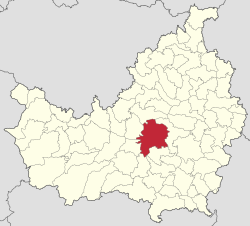Cluj-Napoca | |
|---|---|
| Nickname(s): | |
 Location in Cluj County | |
| Coordinates: 46°46′N 23°35′E / 46.767°N 23.583°E | |
| Country | Romania |
| County | Cluj County |
| Status | County seat |
| Attested | 1213 (first official record as Clus) |
| Government | |
| • Mayor (2020–2024) | Emil Boc[3] (PNL) |
| • Deputy Mayor | Dan Tarcea (PNL) |
| • Deputy Mayor | Emese Oláh (UDMR) |
| • City Manager | Gheorghe Șurubaru (PNL) |
| Area | |
• City | 179.5 km2 (69.3 sq mi) |
| • Metro | 1,537.5 km2 (593.6 sq mi) |
| Elevation | 340 m (1,120 ft) |
| Population | |
• City | 286,598 |
| • Density | 1,597/km2 (4,140/sq mi) |
| • Metro (2011) | 411,379[4] |
| Time zone | UTC+2 (EET) |
| • Summer (DST) | UTC+3 (EEST) |
| Postal Code | 400xyz[i] |
| Area code | +40 x64[ii] |
| Car Plates | CJ[iii] |
| Website | primariaclujnapoca |
| |
Cluj-Napoca (/ˈkluːʒnæˌpoʊkə/ KLOOZH-na-POH-kə; Romanian: [ˈkluʒ naˈpoka] ), or simply Cluj (Hungarian: Kolozsvár [ˈkoloʒvaːr] , German: Klausenburg), is a city in northwestern Romania. It is the second-most populous city in the country[5] and the seat of Cluj County. Geographically, it is roughly equidistant from Bucharest (445 km; 277 mi), Budapest (461 km; 286 mi) and Belgrade (483 km; 300 mi). Located in the Someșul Mic river valley, the city is considered the unofficial capital of the historical province of Transylvania. For some decades prior to the Austro-Hungarian Compromise of 1867, it was the official capital of the Grand Principality of Transylvania.
As of 2021[update], 286,598 inhabitants live in the city.[5] The Cluj-Napoca metropolitan area had a population of 411,379 people,[4][6] while the population of the peri-urban area is approximately 420,000.[4][7] According to a 2007 estimate, the city hosts a visible population of students and other non-residents, an average of over 20,000 people each year during 2004–2007.[8] The city spreads out from St. Michael's Church in Unirii Square, built in the 14th century and named after the Archangel Michael, Cluj's patron saint.[9] The municipality covers an area of 179.52 square kilometres (69.31 sq mi).
Cluj experienced a decade of decline during the 1990s, its international reputation suffering from the policies of its mayor at the time, Gheorghe Funar.[10] In the early 21st century, the city is one of the most important academic, cultural, industrial and business centres in Romania. Among other institutions, it hosts the country's largest university, Babeș-Bolyai University, with its botanical garden; nationally renowned cultural institutions such as the National Theatre and Opera; as well as the largest Romanian-owned commercial bank.[11][12] Cluj-Napoca held the titles of European Youth Capital in 2015,[13] and European City of Sport in 2018.[14] In 2021, the city joined the UNESCO Creative Cities Network and was named a UNESCO City of Film.[15]
- ^ "Portretul unui oraș" (in Romanian). Clujeanul. 21 September 2007. Archived from the original on 24 August 2010. Retrieved 9 October 2008.
- ^ "A kincses város" (in Hungarian). UFI. December 2004. Archived from the original on 2 September 2008. Retrieved 9 October 2008.
- ^ "Results of the 2020 local elections". Central Electoral Bureau. Archived from the original on 9 October 2020. Retrieved 11 June 2021.
- ^ a b c "Rezultate definitive ale Recensământului Populației și Locuințelor – 2011 – analiza". Cluj County Regional Statistics Directorate. 5 July 2013. Archived from the original on 4 May 2014. Retrieved 5 July 2013.
- ^ a b c "Populaţia rezidentă după grupa de vârstă, pe județe și municipii, orașe, comune, la 1 decembrie 2021" (in Romanian). INSSE. 31 May 2023.
- ^ "Zona Metropolitana Urbana" (in Romanian). CJ Cluj. Archived from the original on 31 May 2009. Retrieved 25 May 2009.
- ^ "Zona Metropolitană Urbană și Strategii de Dezvoltare a Zonei Metropolitane Cluj-Napoca" (in Romanian). Cluj County Council. Archived from the original on 14 November 2007. Retrieved 12 March 2008.
- ^ "Wanted: clujeanul verde" (in Romanian). Foaia Transilvană. 6 March 2008. Archived from the original on 11 May 2008. Retrieved 12 May 2008.
- ^ "Catedrala "Sf. Mihail"" (in Romanian). Clujonline.com. Archived from the original on 22 March 2008. Retrieved 12 March 2008.
- ^ "Cluj: Buzz grips university town". Financial Times. 6 March 2008. Archived from the original on 10 December 2022. Retrieved 13 March 2008.
- ^ "Five alive – New regions – Five territories to watch". Monocle. Vol. 1, no. 9. December 2007. Archived from the original on 5 March 2008. Retrieved 12 March 2008.
- ^ Alexandra Groza (8 January 2008). "Presa britanică: "Clujul, campion mondial la dezvoltare"" (in Romanian). Clujeanul. Archived from the original on 4 May 2008. Retrieved 12 March 2008.
- ^ "cluj2015.eu". www.cluj2015.eu. Archived from the original on 17 December 2014. Retrieved 14 December 2014.
- ^ Raluca Sas (6 December 2017). "Cluj-Napoca a câștigat titlul de "Oraș European al Sportului 2018"". monitorulcj.ro (in Romanian). Archived from the original on 23 April 2018. Retrieved 22 April 2018.
- ^ "Cluj-Napoca". Retrieved 8 April 2024.







